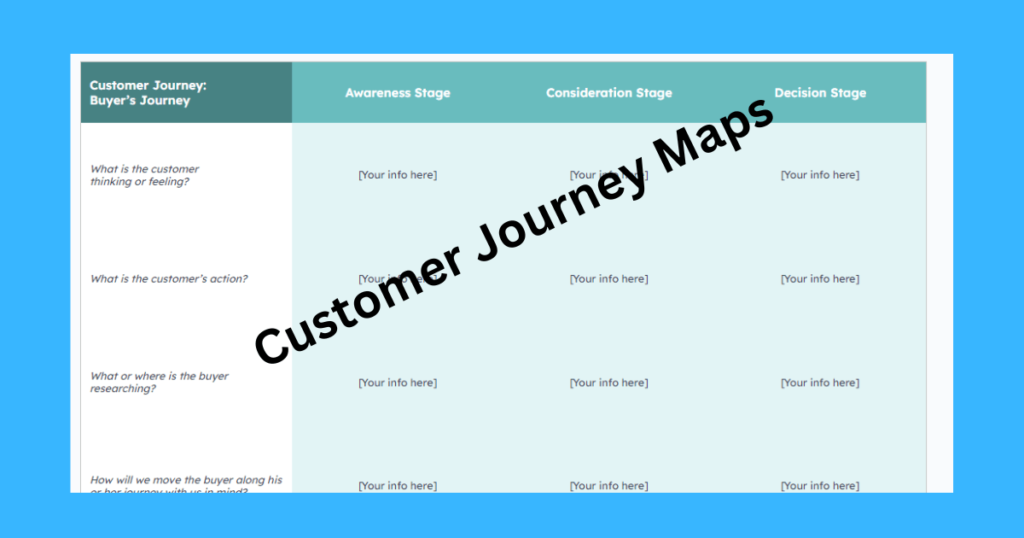Creating a customer journey map helps you understand and analyze the experiences and interactions a customer has with your product or service over time.
We should capture a journey from the customer\’s perspective – highlighting key touchpoints, emotions, and pain points.
That\’s because our end goal is to provide the appropriate Wow! moments and mitigate any negative experiences. Often these discoveries lead to feature or process refinements at every step.
We do that by looking at what to prioritize and improve at every step.
For example,
- For a SaaS platform like Evalinator, the Wow! moment is when a customer successfully creates an assessment and actually uses it to engage their respondents.
- For a tech services firm, a sales wow! moment is when the prospect sees a live solution demo or architecture for an issue they are facing. See a typical B2B sales journey here.
In this post, I\’ll provide an overview of what a journey map is. You can download free templates from Hubspot here.
We\’ll also see examples for 5 different scenarios.
- Scenario 1: Online Retail
- Scenario 2 – B2B Services Firm Approaching Prospects
- Scenarios 3 – B2B Services Firm Growing Existing Clients
- Scenario 4 – B2B Tech Products Company – Enterprise Prospecting
- Scenario 5 – Enterprise Products Company – Growing Accounts
First, let\’s briefly understand what a customer journey map is.
What is a Customer Journey Map?
A journey map typically is made for a customer persona.
We walk through the stages of their engagement with us, and note the following key items.
- Stages: Different phases of the customer\’s journey. Sometimes you may find it best to tackle a small part of the overall journey (e.g. onboarding, or doing a discovery workshop with you).
- Touchpoints: Points of interaction with the customer.
- Actions: What the customer does at each stage.
- Purpose: What does the customer need at each stage?
- Emotions: How the customer feels at each stage. Is it a Wow! moment?
- Pain Points: Challenges or obstacles the customer faces.
- Opportunities: Areas where we can improve the customer experience.
We try to base these customer journey maps on primary research – e.g. data gathering by speaking to customers as part of our ethnographic research.
We need not always make a graphical and pretty looking customer journey map. What matters is that we understand what goes into stage, and what can we do to make it better for our customers and prospects.
Now lets look at multiple examples. In each example, I have the expected stages on the top row, and each of these items in the rows below.
Note:
- I haven\’t done recent a lot of primary research for this blog. This information is a mix of primary research, secondary research (Gartner etc.), and my experiences.
- I also used AI to get ideas – which I refined. So remember to do you own human analysis!
Scenario 1: Online Retail
As you can see, I limited the customer journey map stages.
We are focusing up till the \”add to cart\” stage. That way so we can go into more detail on the actual experience.
If we had included checkout, order status check, returns etc., we would have a more extensive, but less actionable, journey map.
User Persona:
- Name: Alex
- Occupation: Professional
- Tech-savvy: High
- Motivation: Looking for stylish and affordable work attire
| Items/Stages | Research Need | Product Discovery | Product Evaluation | Decision to Add to Cart |
|---|---|---|---|---|
| Purpose | Understand what kind of work attire is needed | Find suitable products | Assess product fit, quality, and value | Decide to add the product to the cart |
| Touchpoints | Retailer’s website, search function | Retailer’s website, search function, product pages | Product pages, customer reviews | Product pages, size guides, availability |
| Actions | Browses categories, searches for trends | Uses site search, browses categories | Reads product descriptions, reviews, and ratings, compares multiple | Considers product details and selects size/color |
| Neutral Emotion | Curious | Engaged | Interested | Contemplative |
| Negative Emotion | Only products are listed, no combinations or advice | No combinations presented, inadequate pictures, difficult to find quality information | Skeptical of quality, unsure about fit | Hesitant due to price or doubts |
| Positive Emotion | Able to visualize attires | Interested | Excited | Confident |
| Pain Points | Too many options, not enough \”job to be done\” focus. | No combinations presented, inadequate pictures, difficult to find quality information | Unclear product descriptions, inconsistent reviews | Uncertainty about sizing, high price, unsure about shipping or pickup |
| Opportunities | Provide filters and recommendations | Provide pictures, visualizations, filters and recommendations | Offer detailed descriptions, high-quality images | Provide size guides, customer service chat, time estimates |
Scenario 2 – B2B Services Firm Approaching Prospects
I\’ve taken the entire sales cycle here. But we can reduce the scope for more detailed analysis. For example, we may consider only one of the 5 stages. Or we may consider the sales pursuit from lead to first meeting.
Persona:
- Name: John
- Occupation: Operations Manager at a mid-sized manufacturing company
- Motivation: Improve operational efficiency and reduce costs
| Items/Stages | Awareness | Consideration | Decision | Onboarding | Implementation | Post-Implementation | Retention |
|---|---|---|---|---|---|---|---|
| Purpose | Learning about the types of issues (downtime, stock supply, scheduling etc.), what causes issues and how to measure them | Considering professional help as an option, and assessing how these options meet company’s needs | Having zoomed into getting external help, choosing the right service provider | Beginning the service relationship, kicking off the project | Successfully defining scope and integrating the new service | Evaluating the impact of the service | Sustaining the business relationship |
| Touchpoints | Industry webinars, trade shows, blogs, infographics | Website, case studies, | Proposal, demos, frameworks, reference calls | Kickoff meeting, project plan | Regular updates, training sessions | Review meetings, performance reports | Quarterly business reviews, additional services |
| Actions | Attends a webinar or trade show, hears about the firm | Visits website, reviews case studies, requests a demo | Reviews proposal, speaks with references | Attends kickoff meeting, receives detailed project plan | Participates in training, receives regular updates | Attends review meetings, receives performance reports | Participates in quarterly reviews, explores additional services |
| Neutral Emotion | Curious | Interested | Confident | Excited | Engaged | Satisfied | Valued |
| Negative Emotion | Information overload | Unclear differentiation from competitors | Cautious | Slightly overwhelmed | Occasionally frustrated | Initial performance issues | Service complacency |
| Positive Emotion | Open-minded | Evaluative | Committed | Motivated | Empowered | Looking for continuous improvement | Loyal |
| Pain Points | Generic presentations | Unclear differentiation from competitors | High cost, decision-making complexity | Complexity of integration, internal resistance | Technical issues, slow progress | Lack of visible quick wins, ongoing support needed | Potential service saturation |
| Opportunities | Present specific, industry-relevant solutions | Highlight unique value propositions, offer detailed demos | Provide clear cost-benefit analysis, detailed implementation plan | Offer thorough onboarding support, clear timelines | Provide responsive support, ensure regular communication | Offer continuous improvement programs, highlight early successes | Propose complementary services, highlight synergy benefits |
Scenarios 3 – B2B Services Firm – Growing Existing Clients
Persona:
- Name: Lisa
- Occupation: Chief Information Officer (CIO) at a large financial firm
- Motivation: Enhance IT infrastructure, ensure data security
| Items/Stages | Ongoing Relationship | Identification of Needs | Proposal of New Services | Decision | Implementation | Review and Improvement | Expansion (moves to phase 1) |
|---|---|---|---|---|---|---|---|
| Purpose | Maintaining a productive relationship | Understanding current and future needs | Evaluating new services | Committing to new services | Integrating new services | Assessing performance and making improvements | Exploring further growth opportunities |
| Touchpoints | Regular check-ins, value communication, relationship reinforcement, satisfactory performance | Needs assessment meetings, innovation showcases, client surveys | Proposal presentation, frameworks, ROI analysis | Contract renewal, pricing, people quality, service agreement | Kickoff meeting, dedicated support | Performance metrics, feedback sessions | Strategic planning sessions, upselling |
| Actions | Participates in regular check-ins, receives performance reviews | Engages in needs assessment, completes surveys | Reviews new service proposals, considers ROI | Reviews and signs new service agreements | Attends kickoff meeting, receives dedicated support | Monitors new service performance, provides feedback | Participates in strategic planning, considers additional services |
| Neutral Emotion | Satisfied | Interested | Evaluative | Confident | Motivated | Satisfied | Valued |
| Negative Emotion | Low satisfaction with current services – quality, communication, partnership etc. | Unclear future needs, potential budget constraints | Cautious | Lengthy approval process, internal buy-in | Occasionally frustrated | Initial performance issues | Potential service saturation |
| Positive Emotion | Pleased with results and communication. Open to new opportunities | Open to suggestions | Confident | Committed | Excited | Looking for enhancements | Loyal |
| Pain Points | Need for continual value | Unclear future needs, potential budget constraints | High investment required, need for justification | Lengthy approval process, internal buy-in | Integration challenges, internal training needs | Initial performance issues, need for quick adjustments | Potential service saturation |
| Opportunities | Provide regular value based updates, introduce new features, build personal rapport, map other stakeholders | Conduct thorough needs analysis, present cost-effective solutions | Offer clear ROI analysis, detailed implementation roadmap | Facilitate smooth approval process, provide strong justifications | Provide comprehensive training, ensure seamless integration | Regular performance reviews, responsive support for adjustments | Propose complementary services, highlight synergy benefits |
Scenario 4 – B2B Tech Products Company – Enterprise Prospecting
Persona:
- Name: David
- Occupation: IT Director at a large corporation
- Motivation: Improve efficiency and productivity through technology solutions
| Items/Stages | Awareness | Consideration | Decision | Onboarding | Implementation | Post-Implementation | Retention |
|---|---|---|---|---|---|---|---|
| Purpose | Learning about pain areas, how to measure, impact, opportunity cost etc. | potential technology solutions as on option and evaluating if the technology solutions meets company\’s needs (among other approaches) | Choosing the right technology provider | Beginning the technology integration | Successfully integrating the technology | Evaluating the impact of the technology | Sustaining the vendor relationship |
| Touchpoints | Industry events, online research, blogs, industry analysts | Product demos, vendor webinars | RFP process, vendor presentations | Kickoff meeting, project plan | Regular updates, training sessions | Review meetings, performance reports | Quarterly business reviews, additional services |
| Actions | Attends industry events, conducts online research | Participates in product demos, attends webinars | Reviews RFP responses, evaluates vendor offerings | Attends kickoff meeting, receives detailed project plan | Participates in training, receives regular updates | Attends review meetings, receives performance reports | Participates in quarterly reviews, explores additional services |
| Neutral Emotion | Curious | Interested | Evaluative | Excited | Engaged | Satisfied | Valued |
| Negative Emotion | Information overload | Unclear differentiation from competitors | Decision-making complexity | Slightly overwhelmed | Technical issues, slow progress | Initial performance issues, need for quick adjustments | Potential service saturation |
| Positive Emotion | Open-minded | Evaluative | Confident | Motivated | Empowered | Looking for continuous improvement | Loyal |
| Pain Points | Generic presentations, lack of information | Unclear differentiation from competitors | High cost, decision-making complexity | Complexity of integration, internal resistance | Technical issues, slow progress | Lack of visible quick wins, ongoing support needed | Potential service saturation |
| Opportunities | Present specific, industry-relevant solutions | Highlight unique value propositions, offer detailed demos | Provide clear cost-benefit analysis, detailed implementation plan | Offer thorough onboarding support, clear timelines | Provide responsive support, ensure regular communication | Offer continuous improvement programs, highlight early successes | Propose complementary services, highlight synergy benefits |
Scenario 5 – Enterprise Products Company – Growing Accounts
Persona:
- Name: Emily
- Occupation: Chief Technology Officer (CTO) at a multinational corporation
- Motivation: Enhance technology infrastructure, drive innovation
| Items/Stages | Ongoing Relationship | Identification of Needs | Proposal of New Services | Decision | Implementation | Review and Improvement | Expansion |
|---|---|---|---|---|---|---|---|
| Purpose | Maintaining a productive relationship | Understanding current and future needs | Evaluating new products and services | Committing to new purchases | Integrating new products | Assessing performance and making improvements | Exploring further growth opportunities |
| Touchpoints | Regular check-ins, performance reviews | Needs assessment meetings, client surveys | Proposal presentations, ROI analysis | Contract renewal, service agreement | Kickoff meeting, dedicated support | Performance metrics, feedback sessions | Strategic planning sessions, upselling |
| Actions | Participates in regular check-ins, receives performance reviews, value reports | Engages in needs assessment, completes surveys | Reviews new product proposals, considers ROI | Reviews and signs new service agreements | Attends kickoff meeting, receives dedicated support | Monitors product performance, provides feedback | Participates in strategic planning, considers additional purchases |
| Neutral Emotion | Satisfied | Interested | Evaluative | Confident | Motivated | Satisfied | Valued |
| Negative Emotion | Satisfaction with current services | Unclear future needs, potential budget constraints | Cautious | Lengthy approval process, internal buy-in | Occasionally frustrated | Initial performance issues | Potential product saturation |
| Positive Emotion | Open to new opportunities | Open to suggestions | Confident | Committed | Excited | Looking for enhancements | Loyal |
| Pain Points | Need for continual value | Unclear future needs, potential budget constraints | High investment required, need for justification | Lengthy approval process, internal buy-in | Integration challenges, internal training needs | Initial performance issues, need for quick adjustments | Potential product saturation |
| Opportunities | Provide regular value updates, introduce new features | Conduct thorough needs analysis, present cost-effective solutions | Offer clear ROI analysis, detailed implementation roadmap | Facilitate smooth approval process, provide strong justifications | Provide comprehensive training, ensure seamless integration | Regular performance reviews, responsive support for adjustments | Propose complementary products, highlight synergy benefits |
Next Steps
Hope these examples were useful.
The bottom line is to be customer centric by bringing in outside-in thinking. If we help a customer along, we win.
You can download free customer journey map templates from Hubspot here.



